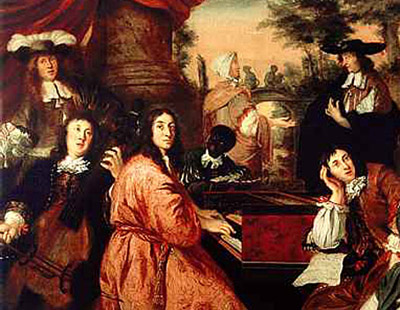| Diderik Buxtehude

| | Buxtehude hade sina rötter i Helsingborg och Helsingör och han arbetade på bägge sidor av sundet, trots krig och ofred i området. Han avslutade sin karriär som organist i Lübeck. |
Buxtehude - en øresundsborger
I årene 1638-41 virkede Buxtehude den ældre i Helsingborg og her tilbragte Diderik nogle barneår. I 1642 fik faderen tjeneste som organist ved Skt. Olai Kirke i Helsingør, hvor han var aktiv frem til 1670. Barne- og ungdomsår tilbragte Diderik Buxtehude altså både i Helsingør og Helsingborg.
Rigt musikliv
I 1600-tallet første halvdel var musiklivet ved det danske hof og i de større kirker af meget høj klasse. Navne som Heinrich Schütz og John Dowland er gået over i musikhistorien. Schütz var kirkemusiker i Købehavn og opbyggede hofkapellet der. Dowland, berømt lutspiller og komponist, var hofmusiker og holdt til i Helsingør. Johann Lorentz virkede i første halvdel af 1600-tallet som kongelig orgelbygger og byggede, eller ombyggede alle vigtige orgler i Øresundsregionen i en da ganske konservativ renæssansestil som da repræsenteredes af Heinrich Schütz og John Dowland. Et af de vigtigste vidnesbyrd om Lotrentz virksomhed findes i orgelfacaden på Chrisstiansstads Trefoldighedskirke.
Organist tur-retur
Diderik Buxtehude gik i sin fars fodspor og blev i 1657 organist i Mariakirken i Helsingborg. 1660 søgte han og fik organistembedet ved Mariakirken i Helsingør. Formodentlig fordi dette embede var bedre lønnet og han dermed kom tættere på resten af familien. I tiden frem til 1668, hvor Buxtehude drager til Lübeck og søger embede der, bor han således i samme hus som faderen og moderen. Huset findes endnu i Helsingørs Skt. Annægade.
Samtidig skede der en modernisering af de gamle Lorenzorgler til en moderne barokstil, en stil som repræsenteres musikalsk af Diderik Buxtehude. Den nordtyske orgelbygger Hans Christoff Frietzsch stod for denne modernisering og han var manden bag om- og nybygning af orgler i København, Helsingør, Halmstad, Helsingborg, Landskrona og Malmö.
Diderik Buxtehude oplevede altså og deltog i en meget aktiv fornyelse af musiklivet gennem de nybygninger som foretoges. To år efter han var flyttet til Helsingør vendte han tilbage til Helsingborg(1662) for at føre tilsyn med ombygningen af orglet i Mariakirken. Dette tyder på at den svenske magtovertagelse af Skåne i 1658 ikke umiddelbart påvirkede musiklivet.

Mariakyrkan i Helsingborg | 
Sct. Annægade i Helsingør | 
Det gamle orgel | 
Buxtehude | 
Kororgel i Mariakyrkan |
Forbindelsen opretholdes
I sin tid i Helsingør opretholder Buxtehude også tætte forbindelser til både danske og svenske embedsborgere. Det eneste med fuldt sikkerhed kendte musikstykke som Buxtehude har skrevet i sin tid i Helsingør er således i året 1665 tilegnet Christoffer Schneider, der var svensk postmester og senere kommisarius bosiddende i Helsingør. Ligeledes havde Buxtehude allerede fra Helsingør-tiden venskabelige forbindelser med den svenske hofkapelmester og organist Gustav Büben. Måske er det også på hans foranledning at Buxtehude i 1680 komponerer bryllupskantaten til brylluppet imellem Karl 11.Gustav og hans danskfødte dronning Hedvig Eleonora.
| |
 | | Stor | Aperte mihi portas justitiae, Helsingør 1665 (Diderik Buxtehude) |
 | | Stor | Aria sopra le Nozze di Sua Maesta il Re de Svecia (1680) (Didrik Buxtehude) |
Tiden i Lübeck
1668 flyttede Diderik Buxtehude til Lübeck, formodentlig af hensyn til sin fortsatte karriere, men nok også for at komme væk fra de trange økonomiske vilkår i den krigshærgede Øresundsregion. Som en rød tråd i Buxtehudes liv går de tre mariakirker i Helsingborg, Helsingør og Lübeck. Selvom størstedelen af hans aktive liv var forlagt til Lübeck og selvom han der vandt den største ære og berømmelse, så glemte han aldrig sine rødder ved Øresund. Derfor kunne tidsskriftet Nova litttraria Maris Balthici år 1707 påstå, at ”han anså Danmark for sit fædreland” (Patriam agnoscit Daniam).
Diderik Buxtehudes karriere som komponist og organist kulminerede i Lübeck, hvortil storheder som Händel og Bach vandrede for at lytte til hans musik. Det var som organist og komponist i Mariakirken i Lübeck han vandt sin store berømmelse. Især var han kendt for sine ”Lübecker Abendmusik” som var koncerter i tilknytning til aftensangen søndagene før jul. Til disse skrev han hvert år et nyt orgelværk. |